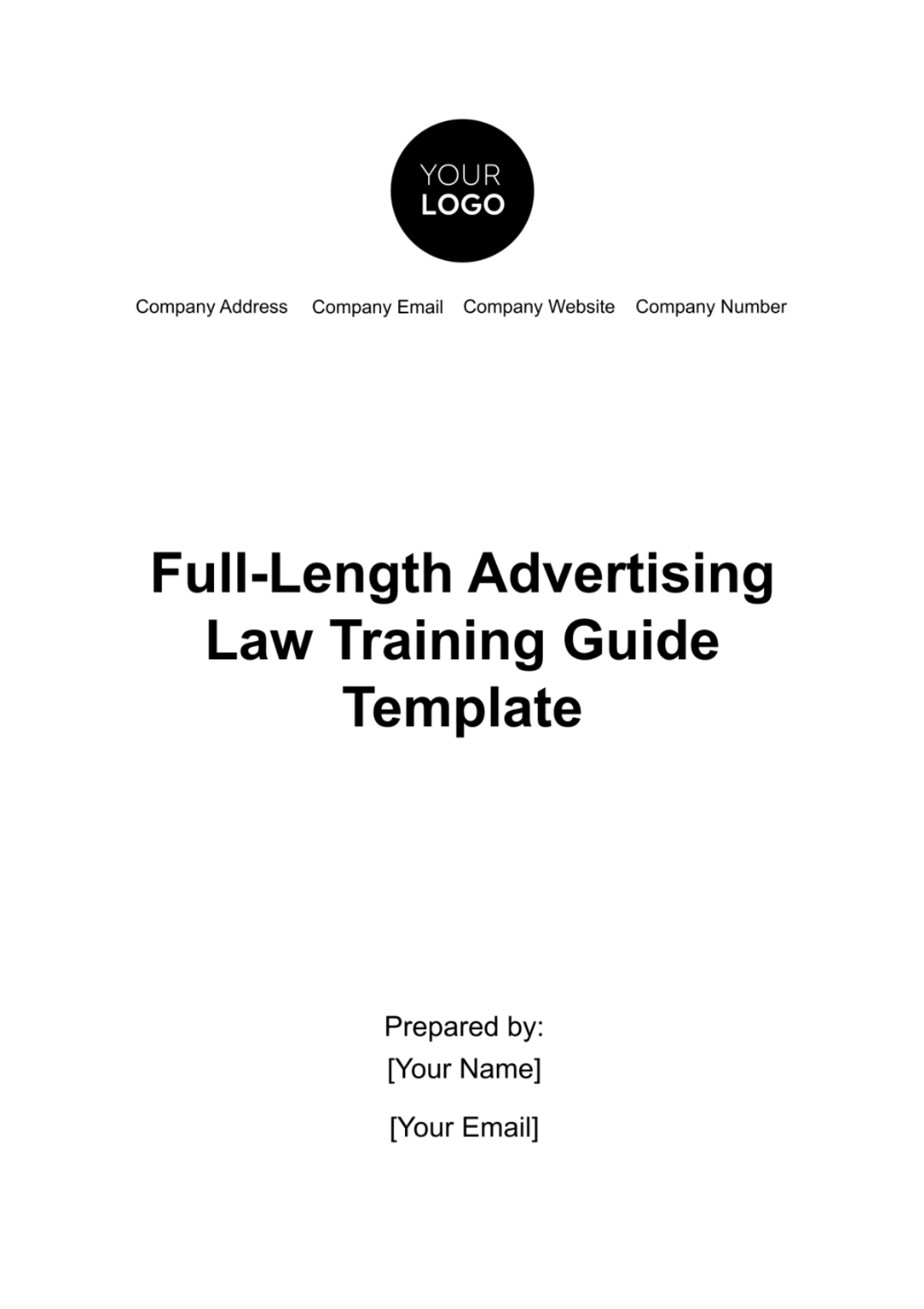Free Full-Length Advertising Law Training Guide

Introduction
[Your Company Name] is committed to helping businesses navigate the complexities of advertising law to ensure compliance and ethical advertising practices. Advertising law serves as a crucial framework to maintain trust and fairness in the marketplace. Its primary purposes include:
A. Consumer Protection: Advertising law safeguards consumers from deceptive or false advertising, ensuring that they make informed purchasing decisions.
B. Competitive Fairness: It promotes fair competition among businesses by prohibiting unfair or deceptive advertising practices that could give one business an unfair advantage.
C. Legal Compliance: Advertisers must adhere to legal requirements and standards to avoid penalties, lawsuits, and damage to their reputation.
Key Regulatory Bodies
A. Federal Trade Commission (FTC)
The Federal Trade Commission (FTC) is the foremost regulatory authority overseeing advertising practices in the United States. Its responsibilities include:
Investigating and taking action against deceptive advertising.
Monitoring advertising campaigns to ensure compliance with FTC guidelines.
Providing guidelines and educational resources to help advertisers understand and comply with the law.
State-Level Regulations
In addition to federal oversight, each state may have its own advertising regulations and enforcement agencies. Advertisers must be aware of these state-specific requirements, which can vary widely.
Legal Framework
A. Federal Trade Commission (FTC)
The FTC Act is a cornerstone of advertising law. It prohibits unfair or deceptive advertising practices and provides guidance on several critical aspects, including:
False Advertising: Advertisers must not make false claims or statements about their products or services.
Endorsements: Guidelines exist for endorsements and testimonials to ensure transparency.
Advertising Ethics
A. Importance of Ethical Advertising
Ethical advertising is the foundation of a sustainable and reputable business. Key reasons to prioritize ethical advertising include:
Customer Trust: Ethical advertising builds trust with consumers, leading to long-lasting relationships and brand loyalty.
Legal Compliance: Ethical advertising practices align with legal requirements, reducing the risk of legal issues.
Positive Brand Image: Ethical advertising enhances your brand's image and reputation, attracting more customers and partners.
B. Ethical Advertising Principles
Ethical advertising is guided by principles such as:
Truthfulness: Advertisements must always convey accurate and verifiable information.
Transparency: Disclose any potential conflicts of interest or affiliations that might affect the perception of the advertisement.
Respect for Privacy: Respect consumers' privacy and obtain consent when collecting their data for advertising purposes.
C. Case Studies on Ethical Violations
Case 1: [Product Name]
In this case, a company falsely claimed that their dietary supplement could cure a specific medical condition without scientific evidence to support the claim. This led to legal action by the FTC, resulting in significant fines and damage to the company's reputation.
Case 2: [Product Name]
This case involved a misleading advertising campaign that concealed important terms and conditions for a product offer. The lack of transparency led to consumer complaints and legal repercussions, emphasizing the importance of ethical advertising practices.
Substantiation and Evidence
A. Substantiating Claims
In advertising, it's crucial to substantiate any claims made about your products or services. This means you must have solid evidence to support the statements you make in your ads. Types of claims that often require substantiation include:
Product Efficacy: If you claim that your product can do something specific, you need evidence to back up that claim.
Comparative Claims: If you compare your product to a competitor's, you must have data to support this.
B. Types of Evidence
To substantiate your claims, you can use various types of evidence, including:
Scientific Studies: Conducting scientific studies and presenting their results can be a powerful way to substantiate claims.
Customer Testimonials: Genuine and unsolicited testimonials from satisfied customers can serve as evidence.
C. Burden of Proof
In advertising, the burden of proof lies with the advertiser. This means that it's your responsibility to provide evidence to support your claims. Failing to do so can result in legal consequences and damage to your brand's reputation.
False Advertising
A. Definition and Elements
False advertising involves making deceptive or misleading claims about a product or service. Elements of false advertising include:
Misrepresentation: Making false statements about a product's features, benefits, or characteristics.
Deception: Leading consumers to believe something about a product that is not true.
B. Consequences of False Advertising
The consequences of engaging in false advertising can be severe and may include:
Legal Penalties: Regulatory bodies such as the FTC can impose fines and sanctions on advertisers found guilty of false advertising.
Consumer Trust Loss: False advertising damages consumer trust, which can lead to a loss of customers and a damaged reputation.
C. Recent Legal Cases
Case 3: [Product Name]
In this recent case, a cosmetics company was found guilty of false advertising for claiming their anti-aging cream could "reverse aging." The FTC imposed a substantial fine, and the company's sales declined significantly due to the loss of consumer trust.
Case 4: [Product Name]
Another case involved a dietary supplement manufacturer falsely claiming that their product could lead to rapid weight loss without the need for diet or exercise. Legal action led to a hefty fine and the removal of the misleading advertisements.
Intellectual Property Rights
A. Trademarks and Copyrights
Intellectual property rights are crucial in advertising. Understanding trademarks and copyrights is essential:
Trademarks: Protect your brand by registering trademarks for your logos, slogans, and brand names.
Copyrights: Ensure that you have the right to use any copyrighted material in your advertisements.
B. Protecting Intellectual Property
Protecting your intellectual property is critical. This includes monitoring for infringement and taking legal action when necessary to safeguard your brand.
Digital Advertising and Privacy
A. Online Advertising Regulations
Online advertising is subject to specific regulations to protect consumer privacy and data. Key aspects of online advertising regulations include:
Data Collection: Advertisers must be transparent about collecting user data and obtain consent in compliance with data protection laws.
B. Data Privacy Laws
Data privacy laws such as the General Data Protection Regulation (GDPR) and the California Consumer Privacy Act (CCPA) impact how advertisers can collect and use personal data for advertising purposes.
C. Data Protection Compliance
Compliance with data protection laws is essential to avoid legal issues. Advertisers must establish robust data protection measures, including data encryption, secure storage, and data access controls.
Comparative Advertising
A. What is Comparative Advertising?
Comparative advertising involves directly or indirectly comparing your product or service to a competitor's. It can be an effective strategy, but it must adhere to specific rules:
Truthfulness: Claims made in comparative advertising must be accurate and substantiated.
Fairness: The comparison should be fair, and the products or services compared should be similar.
B. Legal Considerations
When engaging in comparative advertising, consider potential legal considerations, such as trademark infringement or defamation. Consult with legal experts to ensure compliance.
C. Benefits and Risks
Comparative advertising can provide benefits, including highlighting your product's strengths. However, it also carries risks, such as legal disputes or damaging relationships with competitors.
Advertising to Children
A. Regulations and Restrictions
Advertising to children is subject to specific regulations aimed at protecting vulnerable audiences. Key aspects of regulations include:
Content: Ads must not exploit children's trust, lack of experience, or credulity.
Online Advertising: Special care must be taken in online advertising targeting children, including obtaining parental consent.
B. Case Study: [Your Client User Name]
[Your User Name] successfully navigated the challenges of advertising to children by creating engaging and educational content that complied with regulations. Their case serves as an example of responsible advertising to this demographic.
Global Advertising and International Law
A. Cross-Border Advertising
Expanding your advertising efforts beyond national borders requires careful consideration of international laws and regulations. Key aspects of global advertising include:
Cultural Sensitivity: Be aware of cultural differences and sensitivities when crafting global campaigns.
Translation and Localization: Ensure that your advertising materials are accurately translated and localized for target markets.
B. International Regulations
International regulations, such as the International Chamber of Commerce (ICC) Advertising and Marketing Communications Code, provide guidelines for responsible advertising practices on a global scale.
Compliance and Best Practices
A. Creating a Compliance Strategy
Developing a compliance strategy is crucial for advertising success. Key steps in creating a compliance strategy include:
Regulatory Awareness: Stay informed about advertising regulations relevant to your industry and location.
Staff Training: Ensure that your advertising team is well-versed in legal requirements and ethical standards.
B. Tips for Advertisers
Here are some essential tips for advertisers:
Transparency: Always be transparent about your products or services in your advertising materials.
Regular Audits: Conduct regular audits of your advertising materials to ensure compliance.
Conclusion
Thank you for exploring our Advertising Law Training Advertising Guide. We hope this comprehensive resource has provided you with valuable insights into the intricate world of advertising law. We are dedicated to helping businesses like yours navigate the complex terrain of advertising law while fostering ethical advertising practices that benefit both consumers and advertisers.
If you have any questions, require further assistance, or wish to explore our training and certification programs, please don't hesitate to reach out to us. We look forward to supporting your advertising endeavors and legal compliance needs.
- 100% Customizable, free editor
- Access 1 Million+ Templates, photo’s & graphics
- Download or share as a template
- Click and replace photos, graphics, text, backgrounds
- Resize, crop, AI write & more
- Access advanced editor
Introducing the Full-Length Advertising Law Training Guide Template from Template.net! Dive into comprehensive legal insights effortlessly with this editable and customizable guide. Crafted to perfection, it seamlessly integrates with our Ai Editor Tool, ensuring clarity and ease in understanding complex advertising laws. Elevate your training experience today!





























